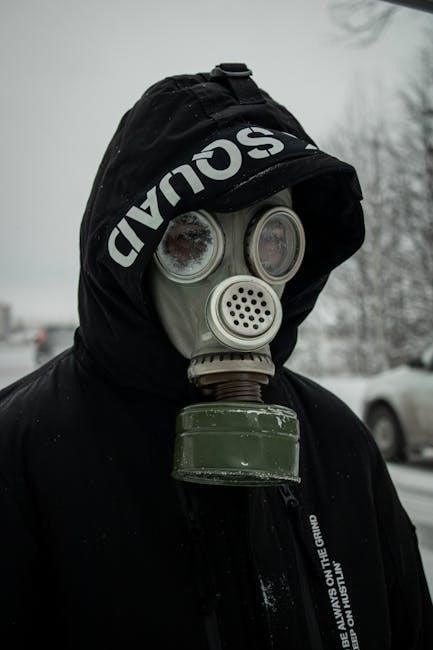
Radiation safety involves protecting individuals and the environment from harmful effects of ionizing radiation. It requires understanding permissible dose limits, measurement units, and essential safety protocols to minimize exposure risks.
1.1. Basic Concepts of Radiation Safety
Radiation safety begins with understanding ionizing and non-ionizing radiation types, their sources, and biological effects. Key concepts include dose limits, measurement units like Sieverts and Rems, and principles such as time minimization, distance, and shielding. The ALARA principle emphasizes reducing exposure to the lowest achievable level. Radiation safety also involves recognizing radiation types, such as X-rays, gamma rays, and beta particles, and understanding their interactions with matter. These fundamentals guide practices to protect workers, patients, and the public from radiation risks.
1.2. Importance of Radiation Safety Training
Radiation safety training is crucial for ensuring compliance with regulations, minimizing exposure risks, and preventing accidents. It equips individuals with knowledge on handling radioactive materials, using protective equipment, and emergency procedures. Training fosters a culture of safety, enabling workers to recognize hazards and apply best practices. Regular updates on new technologies and guidelines are essential to maintain proficiency and adapt to evolving radiation safety standards in various industries, ensuring the well-being of both workers and the public.

Radiation Exposure Limits and Regulations
Radiation exposure limits are set to protect workers and the public from ionizing radiation risks. Regulatory bodies like the ICRP establish guidelines, ensuring doses remain below safe thresholds, typically 20 mSv annually for workers and 1 mSv for the public, emphasizing the ALARA principle to minimize exposure.
2.1. Permissible Radiation Dose Limits
Permissible radiation dose limits are established to protect workers and the public from ionizing radiation risks. For most workers, the annual limit is 20 millisieverts (mSv), while for the general public, it’s 1 mSv. These limits ensure that exposure remains as low as reasonably achievable (ALARA). Regulatory bodies like the ICRP set these guidelines to prevent health risks associated with radiation, such as cancer and genetic mutations, ensuring safety in medical and industrial applications.
2.2. Units of Radiation Measurement
Common units of radiation measurement include the Gray (Gy) for absorbed dose, Sievert (Sv) for equivalent dose, and Becquerel (Bq) for radioactivity. The Gray measures energy absorbed per kilogram of tissue, while Sieverts account for biological effects. Becquerels quantify decay rates. These units help assess exposure risks, ensuring compliance with safety standards and proper dosimetry. Understanding them is crucial for effective radiation safety practices and maintaining exposure levels within permissible limits.
2.3. The ALARA Principle (As Low As Reasonably Achievable)
The ALARA principle aims to minimize radiation exposure to levels as low as reasonably achievable, considering practical and economic factors. It emphasizes optimizing safety by reducing both the duration and intensity of exposure. Techniques include using time limits, maximizing distance, and employing shielding. ALARA ensures that radiation levels remain well below regulatory limits, promoting a safer environment for workers and the public while maintaining operational efficiency and effectiveness in various applications.
Radiation Safety Measures
Radiation safety measures include minimizing exposure time, using shielding, and employing personal protective equipment. Proper handling of radioactive materials and regular monitoring with dosimeters ensure a safe environment.

3.1. Personal Protective Equipment (PPE) in Radiation Safety
Personal Protective Equipment (PPE) is essential for minimizing radiation exposure. Common PPE includes lead aprons, gloves, thyroid collars, and eyewear. These items are designed to shield against ionizing radiation, reducing absorption by sensitive tissues. Proper fitting and use of PPE are critical to ensure effectiveness. Regular inspection and maintenance of PPE are required to maintain its protective integrity. Dosimeters are also worn to monitor cumulative radiation exposure, ensuring safety limits are not exceeded.
3.2. Shielding and Distance in Radiation Protection
Shielding and distance are critical in radiation protection. Shielding involves using materials like lead or concrete to absorb or block radiation, effectively reducing exposure. Increasing distance from the radiation source also minimizes exposure, as radiation intensity decreases with the square of the distance. These methods, combined with time minimization, adhere to the ALARA principle, ensuring exposure levels remain as low as reasonably achievable while maintaining safety and compliance with radiation protection standards.
3.3. Time Minimization in Radiation Exposure
Minimizing exposure time is a cornerstone of radiation safety, aligning with the ALARA principle. Reducing the duration of exposure lowers cumulative radiation dose, decreasing health risks. Techniques include streamlining procedures, using automated tools, and ensuring tasks are completed efficiently. Training and experience play a crucial role in achieving this, as skilled individuals can perform tasks more quickly. Time minimization balances operational needs with dose reduction, ensuring safety without compromising task effectiveness, thus protecting workers and maintaining compliance with radiation exposure limits.

Radiation Safety in Medical Procedures
Radiation safety in medical procedures requires minimizing exposure through proper shielding, informed consent, and using the least radiation necessary, with effective training ensuring compliance with safety protocols.
4.1. Safe Handling of Radioactive Materials
Safe handling of radioactive materials requires strict adherence to protocols, proper storage, and labeling. Personnel must use appropriate PPE, including gloves and lab coats, to minimize direct contact. Training on radiation safety is essential to ensure compliance with regulations. Regular monitoring of radiation levels and proper waste disposal are critical. Handling should be minimized to reduce exposure, and tools like tongs or forceps should be used when possible. Proper shielding and storage in designated areas are vital to prevent accidental exposure and contamination.
4.2. Radiation Protection During X-ray and CT Scans
Radiation protection during X-ray and CT scans involves minimizing exposure while ensuring diagnostic image quality. Patients should be justified for scans, and dose levels optimized. Lead aprons and thyroid collars are essential for shielding sensitive areas. Proper training for operators ensures correct positioning and technique. Regular maintenance of equipment is critical to prevent unnecessary radiation leakage. pregnant patients require extra precautions. Informing patients about risks and benefits promotes awareness and cooperation. Strict adherence to ALARA principles ensures safety for both patients and staff.

Emergency Procedures in Radiation Incidents
Emergency procedures include evacuating the area, securing radiation sources, and notifying radiation safety experts. Immediate actions focus on minimizing exposure and preventing further contamination or leaks.
5.1. Decontamination Procedures After Radiation Exposure
Decontamination involves removing radioactive material from affected areas to prevent further exposure. Immediate steps include removing contaminated clothing, flushing exposed skin with water, and using specialized cleaning solutions. In cases of ingestion or inhalation, medical intervention is critical. Survey meters are used to monitor contamination levels, ensuring thorough cleanup. Contaminated materials must be sealed and disposed of according to regulations. Training in decontamination procedures is essential for effective response, minimizing health risks, and preventing environmental contamination.
5.2. Management of Radiation Spills and Leaks
Managing radiation spills and leaks requires immediate action to contain and mitigate exposure risks. Evacuate the area, secure access, and notify radiation safety personnel. Use absorbent materials to contain liquids and prevent spread. Survey meters measure radiation levels to assess contamination. Decontaminate surfaces, and dispose of waste according to regulations. Documentation and post-incident reviews are crucial for improving future responses. Training ensures effective handling of such incidents, protecting both people and the environment from potential harm.

Radiation Safety Instruments and Tools
Dosimeters measure radiation exposure, while survey meters assess radiation levels in the environment. Proper calibration and maintenance of these tools ensure accurate readings and reliable safety monitoring.
6.1. Dosimeters and Survey Meters
Dosimeters measure cumulative radiation exposure, ensuring compliance with safety limits. Survey meters assess real-time radiation levels, helping to identify potential hazards. Both tools are crucial for monitoring and maintaining a safe working environment in radiation-exposed settings. Proper use and calibration are essential to ensure accurate readings and effective radiation protection. These instruments are vital for safeguarding workers and preventing overexposure to harmful radiation.
6.2. Calibration and Maintenance of Radiation Safety Instruments
Regular calibration and maintenance of radiation safety instruments ensure accuracy and reliability in measuring exposure levels. Dosimeters and survey meters must be checked against standardized sources to guarantee precise readings. Proper maintenance involves cleaning, updating software, and replacing worn components. Calibration intervals are typically defined by regulations or manufacturer guidelines. Neglecting these steps can lead to equipment failure, exposing workers to potential radiation hazards and compromising safety protocols.
Health Effects of Radiation Exposure
Radiation exposure can cause acute symptoms like nausea or chronic conditions such as cancer and genetic mutations, emphasizing the importance of strict safety measures to minimize risks.
7.1. Acute and Chronic Radiation Exposure Effects
Acute radiation exposure causes immediate symptoms like nausea, burns, and organ failure, while chronic exposure leads to long-term health issues such as cancer and genetic mutations. Ionizing radiation damages DNA, increasing cancer risk over time. Chronic effects may appear years after exposure, emphasizing the importance of minimizing dose and adhering to safety protocols to reduce both immediate and delayed health risks associated with radiation.
7.2. Long-term Health Risks of Radiation Exposure
Long-term radiation exposure increases risks of cancer, genetic mutations, and other health issues. Ionizing radiation can cause DNA damage, leading to tumor growth and hereditary disorders. Prolonged low-dose exposure is linked to leukemia and solid cancers. Radiation-induced health effects may manifest years post-exposure, highlighting the need for strict safety measures and monitoring to mitigate these risks and protect individuals from severe, lasting consequences of radiation exposure.

Radiation Safety in Industrial Applications
Radiation safety in industrial applications ensures safe use of radioactive materials in processes like radiography and material testing, emphasizing proper handling and storage to minimize exposure risks.
8.1. Radiation Safety in Radiography and Industrial Processes
Radiography in industrial settings involves using X-rays or gamma rays to inspect materials for defects. Safety measures include proper shielding, limiting exposure time, and using personal protective equipment. Regular calibration of equipment is crucial to ensure accurate radiation levels. Training personnel on handling radioactive sources and emergency procedures is essential. Adhering to ALARA principles minimizes doses. Proper storage and transport of radioactive materials prevent accidental exposure, ensuring a safe working environment for all employees involved in industrial radiography processes.
8.2. Transport and Storage of Radioactive Materials
Transporting radioactive materials requires strict adherence to safety protocols, including proper shielding, labeling, and secure containers. Storage must occur in controlled, accessible areas with limited entry. Materials should be kept in leak-proof, appropriately marked containers to prevent accidental exposure. Regular inspections ensure compliance with regulations. Proper documentation and tracking during transport and storage are essential to maintain safety and accountability, minimizing risks to personnel and the environment.
Public Awareness and Education
Public awareness and education are crucial for understanding radiation risks and benefits, reducing fears, and promoting safety. They empower individuals to make informed decisions.
9.1. Understanding Radiation Risks and Benefits
Understanding radiation risks and benefits is essential for informed decision-making. While radiation exposure increases cancer risks, it also offers medical benefits like X-rays and cancer treatment. Education helps balance these aspects, fostering awareness of safety measures and the importance of minimizing unnecessary exposure. Public understanding reduces fears and promotes rational approaches to radiation use in medicine, industry, and research.
9.2. Communicating Radiation Safety to the Public

Effective communication of radiation safety to the public involves clear, accessible language to address concerns and dispel myths. Public awareness campaigns should emphasize risks and benefits, fostering trust and understanding. Educational materials, such as radiation safety questions and answers in PDF formats, provide accessible resources for the public to learn about radiation exposure limits, protective measures, and the importance of adhering to safety guidelines in various settings.
Understanding radiation safety is crucial for protecting health and the environment. Educational resources, like radiation safety questions and answers in PDFs, enhance knowledge and promote continuous learning effectively.
10.1. Summary of Key Radiation Safety Principles
Key radiation safety principles include minimizing exposure through time, distance, and shielding. Adhering to dose limits, using PPE, and understanding radiation units like Sieverts and Becquerels are essential. The ALARA principle emphasizes reducing exposure to levels as low as reasonably achievable. Proper handling of radioactive materials, regular monitoring with dosimeters, and following emergency protocols ensure safety. Education and training are critical for maintaining awareness and compliance with regulations, safeguarding both individuals and the environment from radiation risks.
10.2. The Importance of Continuous Learning in Radiation Safety
Continuous learning in radiation safety is crucial for staying updated on regulations, technologies, and best practices. It ensures professionals maintain competence and adapt to evolving risks. Regular training helps reinforce key principles, such as dose limits and emergency protocols, while fostering a culture of safety; By engaging with resources like radiation safety questions and answers PDFs, individuals can enhance their knowledge and apply it effectively in real-world scenarios, ensuring ongoing protection for themselves and others.
